After Sibelius gave up active work on the eighth symphony, his rhythm of life changed.
"Father spent more time outdoors, and he did a lot of reading," his daughter Katarina recollected. "There were perhaps more guests, the number of descendants [grandchildren, soon also great-grandchildren] was increasing. He often went for walks with Eero Järnefelt. They enjoyed each other's company. The family listened to music and visited art exhibitions."
Margareta and Heidi were now married. The nursery was transformed into a library, and Sibelius began to sit in the corner chair in the evenings, listening to the radio. When he tuned in to foreign radio stations he mainly sought performances of his own works.
He continued to compose. But before his 70th birthday in 1935, Sibelius gave a great number of interviews, one of which contained a spine-chilling revelation. "He has discarded a whole year's work, an orchestral work, without hesitation," Elsa von Born wrote. The composer may have decided to carry out a complete revision of his eighth symphony.
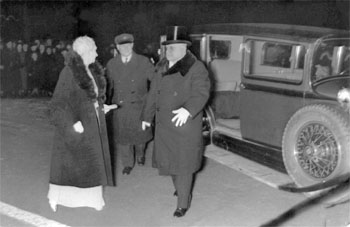
Jean Sibelius arriving for his birthday celebrations in the Exhibition Hall in 1935.
Sibelius's 70th birthday was an international media event. In the United States, Britain and the Nordic countries, he was now the most popular living composer. The New York Philharmonic carried out a survey of the musical preferences of those who tuned in to the broadcasts of its Sunday concerts. The results were published in the New York Times at the end of November. When 12,000 listeners around the United States were asked who their favourite composer was among those whose works had been broadcast, Sibelius came first, ahead of Beethoven and Ravel.
In a jubilee article, the London Times raised the question of the progress of the eighth symphony. This irritated the composer. "One very important factor was the premature fuss that was made about the eighth symphony," was his daughter Katarina's opinion. "Father was unhappy. It was indescribably difficult. He could not evaluate his own strength and estimate when it would be ready. – It was really pretty awful, the way people were waiting for it and asking about it. He thought that he himself should mature with age. He wanted it to be better than the other symphonies. Finally it became a burden, even though so much of it had already been written down. In the end I don't know whether he would have accepted what he had written."
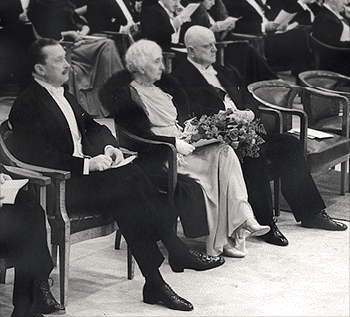
Mannerheim, Aino and Jean Sibelius at
the composer's 70th birthday celebration.
Honours were heaped on the 70-year-old composer. Germany awarded him its highest artistic distinction, the Goethe Medal. The Nazis had seized power, and the award was signed by the Chancellor of the Reich, A. Hitler.
The banquet in Sibelius's honour was the occasion of his last major performance in public. Aino Sibelius was happy to sit next to her idol, Carl Gustaf Emil Mannerheim. The loudspeakers blared out Sibelius's second symphony from a radio broadcast, with Otto Klemperer conducting the New York Philharmonic.
The festivities went well, but the aging Sibelius was so embarrassed by the tremor in his hands that he avoided public events after this.
Nevertheless, throughout the 1930s Sibelius continued to meet interesting artists and figures from different fields, both at Ainola and in Helsinki: the singer Marian Anderson, the violinist Guila Bustabon, Olin Downes, Cecil Gray and many foreign journalists whom he agreed to see at the request of the Finnish Foreign Ministry.
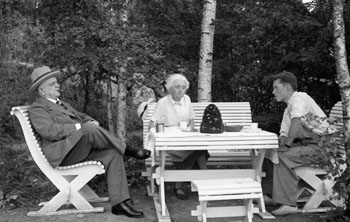
A coffee break in the park of Ainola. Jean and Aino Sibelius with their grandson Erkki Virkkunen.
Sibelius's days passed reading newspapers and books, following his grandchildren play and listening to the radio. The nights the composer still partly devoted to work. It is unclear how far the eighth symphony progressed, but in the late 1930s the composer managed to revise several of his old works and send them to his publisher. In 1939 he wrote new versions of, for example, Lemminkäinen and the Maidens of Saari and Lemminkäinen in Tuonela for publication. However, the publication was delayed until 1954.
In January 1939 Sibelius surprisingly agreed to one more performance as a conductor. He conducted the Finnish Radio Symphony Orchestra in a radio broadcast to celebrate the New York World Exhibition. The public were not admitted. The musicians noted the tremor in the composer's hands, but it did not disturb the short rehearsal and performance. This is the only recording that provides a document of Sibelius's art as a conductor.
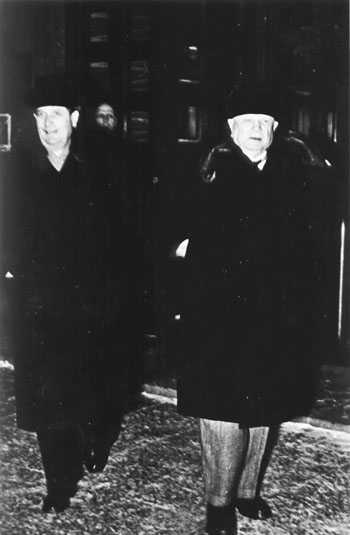
Arvi Paloheimo escorting Jean Sibelius to conduct the broadcast of January 1939.
Sibelius conducted his new arrangement of Andante festivo, which he had originally written in 1922. The tempo is slow and solemn. The orchestral string tone is singing, but slightly coarse - it was clearly recorded after only one general rehearsal. Sibelius keeps up the basic tempo with high professionalism, creating utterly unforced rubatos. Using his privilege as the composer of the work, he now and then deviates considerably from the tempi in the score.
Andante festivo, rehearsal
Rehearsal for the broadcast to celebrate the New York World Exhibition on 1st January 1939. The hum of voices at the beginning of the rehearsal and the tuning of the instruments, the sound of Sibelius's steps and the applause for the composer. On this very unclear tape, Sibelius asks whether Finnish is to be spoken, then starts the rehearsal.
Andante festivo, harjoitus.mp3
Andante festivo, harjoitus_56k.rm
Andante festivo, harjoitus_isdn.rm
Andante festivo, harjoitus_xdsl.rm
Later, a more polished and even slower recording of the Andante festivo was accidentally labelled as "the version conducted by Sibelius", although the conductor must have been someone else, possibly Toivo Haapanen. The authentic performance conducted by Sibelius himself was issued for the first time on a record distributed along with volume 2/1995 of the music magazine Classica.
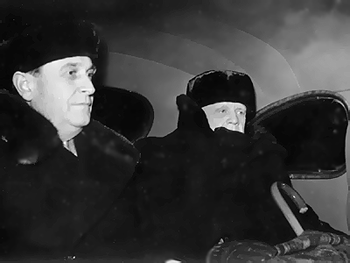
Arvi Paloheimo and Jean Sibelius after the recording of the Andante festivo on 1st January 1939.



